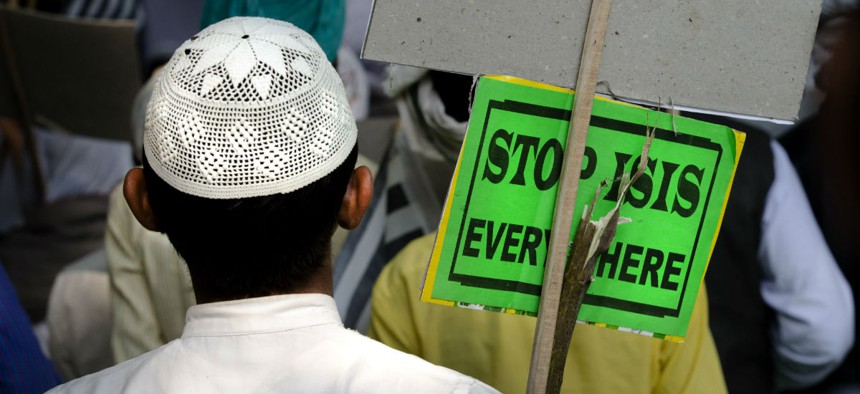
Manish Swarup/AP
Why Attacking ISIS Won't Make Americans Safer
U.S. presidential candidates are steering the country toward a terror trap.
For close to a decade, the trauma of the Iraq War left Americans wary of launching new wars in the Middle East. That caution is largely gone. Most of the leading presidential candidates demand that the United States escalate its air war in Iraq and Syria, send additional Special Forces, or enforce a buffer zone, which the head of Central Command, General Lloyd Austin, has said would require deploying U.S. ground troops. Most Americans now favor doing just that.
The primary justification for this new hawkishness is stopping the Islamic State, or ISIS, from striking the United States. Which is ironic, because at least in the short term, America’s intervention will likely spark more terrorism against the United States, thus fueling demands for yet greater military action. After a period of relative restraint, the United States is heading back into the terror trap.
To understand how this trap works, it’s worth remembering that during the Cold War, the United States had relatively few troops in the Arab and Muslim world. When Ronald Reagan was elected president, Central Command, which oversees U.S. military operations in the Middle East and Central Asia, did not even exist. All of this changed in 1990, when Saddam Hussein invaded Kuwait, and President George H. W. Bush dispatched 700,000 troops to expel him and defend Saudi Arabia. After the war was won, thousands stayed to deter Saddam, and to enforce no-fly zones over Iraq.
Before the Gulf War, the Saudi native Osama bin Laden and his associates had focused on supporting the mujahideen, who were fighting to repel the Soviet occupation of Afghanistan. But after the U.S.S.R.’s withdrawal from Afghanistan in 1989, al-Qaeda turned its attention to the United States, and in particular to America’s military presence in Saudi Arabia. In 1992, al-Qaeda issued a fatwa calling for attacks on American troops in the Middle East. After the United States intervened in Somalia later that year, Somali rebels allegedly trained by al-Qaeda shot down two Black Hawk helicopters. In 1995, al-Qaeda operatives took credit for bombing a joint U.S.-Saudi military facility in Riyadh. And in 1996, a truck bomb devastated a building housing U.S. Air Force personnel in the Saudi city of Dhahran. (Although Saudi Hezbollah carried out the attack, the 9/11 Commission noted “signs that al-Qaeda played some role.”) That same year, another al-Qaeda fatwa declared, “The latest and the greatest of these [Western] aggressions … is the occupation of the land of the two Holy Places”: Saudi Arabia. On August 7, 1998, the eighth anniversary of the beginning of that “occupation,” al-Qaeda bombed America’s embassies in Kenya and Tanzania.
The fact that al-Qaeda justified its attacks as a response to American “occupation” makes them no less reprehensible, of course. And al-Qaeda might well have struck American targets even had the U.S. not stationed troops on Saudi soil. After all, as a global superpower, the United States was involved militarily all across the world in ways al-Qaeda interpreted as oppressive to Muslims.
Still, it’s no coincidence that bin Laden and company shifted their focus away from the U.S.S.R. after Soviet troops left Afghanistan and toward the United States after American troops entered Saudi Arabia. Key advisers to George W. Bush recognized this. After U.S. forces overthrew Saddam in 2003, Deputy Secretary of Defense Paul Wolfowitz said one of the benefits “that has gone by almost unnoticed—but it’s huge—is that by complete mutual agreement between the U.S. and the Saudi government we can now remove almost all of our forces from Saudi Arabia.” The United States, he reasoned, had thus eliminated “a huge recruiting device for al-Qaeda.”
The problem was that to remove thousands of troops from Saudi Arabia, the United States sent more than 100,000 to invade and occupy Iraq. A dramatic surge in terrorist attacks against American and allied forces ensued. As Robert Pape, the director of the Chicago Project on Security and Terrorism at the University of Chicago, has enumerated, the world witnessed 343 suicide attacks from 1980 to 2003, about 10 percent of them against America and its allies. From 2004 to 2010, by contrast, there were more than 2,400 such attacks worldwide, more than 90 percent of them against American and coalition forces in Iraq, Afghanistan, and elsewhere.
Many of those attacks were orchestrated by al-Qaeda’s Iraqi affiliate, which in 2006 established the Islamic State of Iraq. After weakening in 2007 and 2008 (when the U.S. paid Sunni tribal leaders to fight jihadists), the Islamic State strengthened again as the Obama administration’s inattention allowed Iraq’s Shia prime minister, Nuri al-Maliki, to intensify his persecution of Sunnis. Then, after Syrians rebelled against Bashar al-Assad, the Islamic State expanded across Iraq’s western border into Syria, later renaming itself the Islamic State of Iraq and Syria.
Significantly, when the last American troops left Iraq, in December 2011, ISIS did not follow them home. “In its various incarnations,” notes Daniel Byman, a counterterrorism expert who is a professor at Georgetown, the Islamic State “focused first and foremost on its immediate theater of operations.” AlthoughISIS was happy if people inspired by its message struck Western targets, it made little effort to orchestrate such attacks. Research fellows at the Norwegian Defence Research Establishment detected only four ISIS-related plots in the West from January 2011 to May 2014.
But beginning in the fall of 2014, the number of ISIS-related plots in the West spiked. The Norwegian researchers counted 26 from July 2014 to June 2015 alone. What explains the rise? The most plausible explanation is that the Islamic State started targeting Western countries because they had started targeting it. In August 2014, the United States began bombing ISIS targets to protect the Yazidi religious sect in northern Iraq, which ISIS was threatening with extermination. France joined the air campaign the following month. Since then, ISIS seems to have moved from merely inspiring attacks against the West to actively planning them. November’s attacks in Paris, writes Byman, were the “first time that ISIShas devoted significant resources to a mass-casualty attack in Europe.” Afterward, ISIS released a video warning the people of France: “As long as you keep bombing you will not find peace.”
In the wake of the Paris attacks, the Republican presidential candidate Marco Rubio declared that the reason ISIS targets the West is “because we have freedom of speech, because we have diversity in our religious beliefs … because we’re a tolerant society.” Yet only weeks earlier, ISIS had downed a Russian airliner over the Sinai, thus targeting the distinctly intolerant regime of Vladimir Putin. The Islamic State’s justification for that attack was identical to the one it gave for its attack on France: It was bombing Russia because Russia had bombed it.
All of which suggests that the more America intensifies its war against ISIS, the more ISIS will try to strike Americans. And the more terrorism ISIS manages to carry out, the more fiercely America will escalate its air attacks, thus creating the civilian casualties that, according to the International Crisis Group’s Noah Bonsey, “tremendously help the narrative of a jihadi group like the Islamic State.” If the public reaction to Paris and the December attack in San Bernardino is any guide, continued jihadist terrorism will also lead to a rising demand for American ground troops. That, argues the French ISIS expert Jean-Pierre Filiu, would be the worst trap America could fall into, because ISIS wants to cast itself as the Islamic world’s defender against a new crusader invasion.
Despite these dangers, there is a case for attacking ISIS. Part of it is humanitarian: Millions of people now live in a caliphate in which many women cannot leave their homes unless accompanied by a man, and religious minorities can be sold as slaves. Allowing ISIS to expand, and potentially threaten Jordan or Saudi Arabia, would produce misery on an epic scale, intensify the refugee crisis already roiling Europe, and destroy America’s reputation as the underwriter of Middle Eastern order.
But the war isn’t being sold on these grounds. The presidential candidates are not telling Americans that a greater short-term terrorist threat is the price they must pay to liberate oppressed Arabs, protect friendly regimes, and prevent a greater danger down the road. Instead, candidates are promising, at least implicitly, that if America intensifies its war, the terrorist threat will decrease.
What happens when they’re proved wrong? In a political environment where candidates won’t admit that ISIS attacks are partly a response, albeit a monstrous one, to the United States’ own use of force, further attacks will leave Americans even more bewildered and terrified than they are now. Some will gravitate to politicians who promise that with greater force, including ground troops, they can deliver a decisive military victory. Other Americans, desperate for a quick fix, will support further assaults on the rights of Muslims in the United States. Both impulses will help the Islamic State. And America will slide deeper into the terror trap.
The core problem is that most politicians are still selling war on the cheap. They won’t admit that, no matter how convinced Americans may be of their good intentions, the violence the U.S. inflicts overseas will lead others to try to do violence to it. The more fervently the U.S. tries to kill ISIS supporters, the more fervently they will try to kill Americans. And in today’s interconnected world, they will have more opportunities to strike than ever before.
Wars, even necessary ones, are usually costly for both sides. If the men and women running for president won’t admit that, they shouldn’t be demanding war at all.
NEXT STORY: The F-35 Has a Scary List of Bugs







